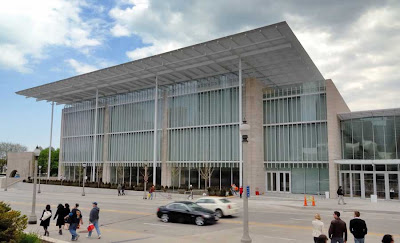The Art Institute of Chicago is celebrating the May 16 opening of its new Modern Wing with a week of free admission. The 264,000-square-foot Renzo Piano-designed addition is the largest expansion in the museum's history. The Modern Wing increases the museum's size to more than a million square feet, making it the second largest art museum in the United States.
 Image (copyright Charles G. Young),click 2 enlarge
Image (copyright Charles G. Young),click 2 enlargeThe building is Consisting of two pavilions flanking the Kenneth and Anne Griffin Court, the central circulation area, the Modern Wing offers three floors of gallery space and amenities, including a museum shop, new ticketing and coat check facilities, a cafe and fine-dining restaurant, and an interior garden. The east pavilion houses the education center as well as photography and film, video, and new media galleries on the first floor, galleries for the museum's permanent collection of contemporary art on the second floor, and galleries for the permanent collection of modern European art on the third floor, under an innovative sun shade system that allows natural light into the galleries. All three floors of the east pavilion feature full-length striking views of Millennium Park and the city beyond, a vantage point not available from any other location in Chicago. The exterior of the building features new landscaping by Gustafson Guthrie Nichol Ltd. along Monroe Street and Columbus Avenue and in the new Brooks McCormick Court, home of the preserved Chicago Stock Exchange Arch designed by Louis Sullivan. Gustafson Guthrie Nichol also designed the Lurie Garden across the street from the Modern Wing in Millennium Park.
 Image (copyright Charles G. Young),click 2 enlarge
Image (copyright Charles G. Young),click 2 enlargeRenzo Piano designed a canopy, or "flying carpet," of precisely modeled aluminum blades that allow northern light into the third floor galleries through skylights while shielding the galleries from the more intense southern light. The flying carpet hovers above the third floor skylights, echoing the flat plane of the lake to the east and allowing the Modern Wing to use an estimated 50% less energy for light and heat than the existing building.
 Image (copyright Charles G. Young),click 2 enlarge
Image (copyright Charles G. Young),click 2 enlargeThe top-floor galleries begin and end with works by Pablo Picasso, demonstrating the steady march toward increasing abstraction by such artists as Piet Mondrian and Constantin Brancusi. The added space also allows display of more of the museum's surrealist collection, some of which were kept in storage.
The second floor is devoted to European and American Art from 1950 to the present, including a room devoted to the color field paintings of Ellsworth Kelly. In the Gerhardt Richter room, location of the German painter's pieces play on Piano's theme of ambient lighting, with Richter's all-gray works facing away from windows and his color panels receiving outdoor light obliquely.
 Image (copyright Andrew Campbel),click 2 enlarge
Image (copyright Andrew Campbel),click 2 enlargeThe wing's windows also will likely be a major draw since they frame Millennium Park and its Frank Gehry-designed music pavilion and the city's looming skyline. The wing's third floor connects to the park through a cantilevered bridge, which stretches across Monroe Street.
The first floor houses a grand entrance, new photography and temporary exhibition galleries, an educational center, offices, a high-end restaurant, and a new gift shop. Despite the amenities, some critics have pointed out that only 65,000 square feet of the Modern Wing has been devoted to new gallery space.
More Information: www.artic.edu/
Recommended Books:

Piano: Renzo Piano Building Workshop 1966-2008
By Philip Jodidio


No comments:
Post a Comment